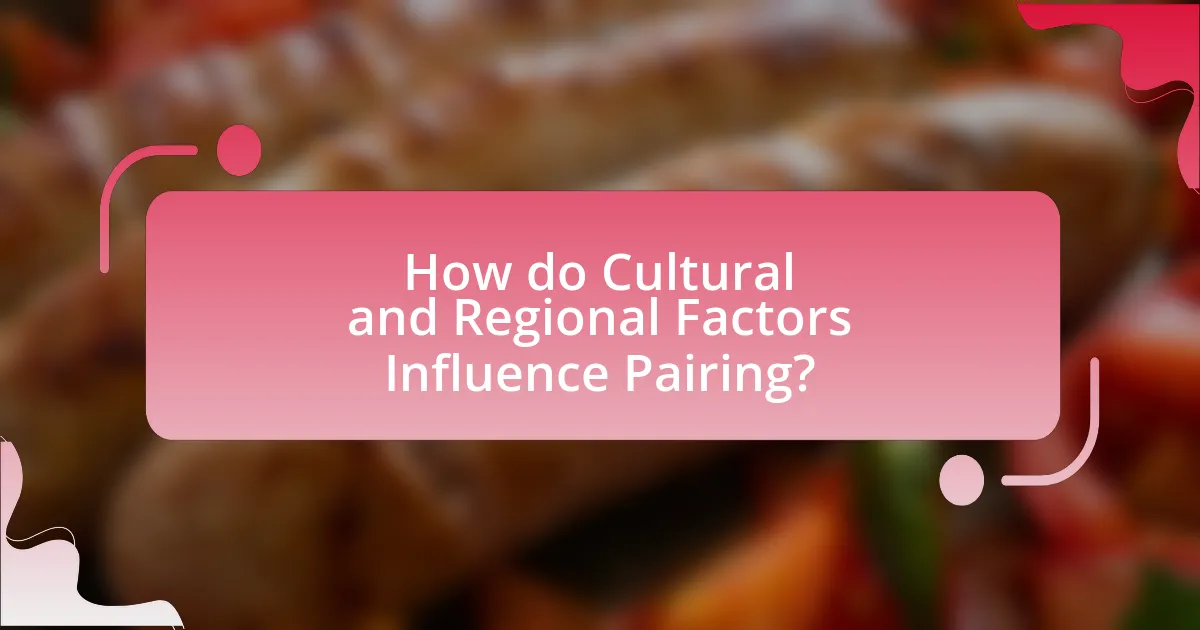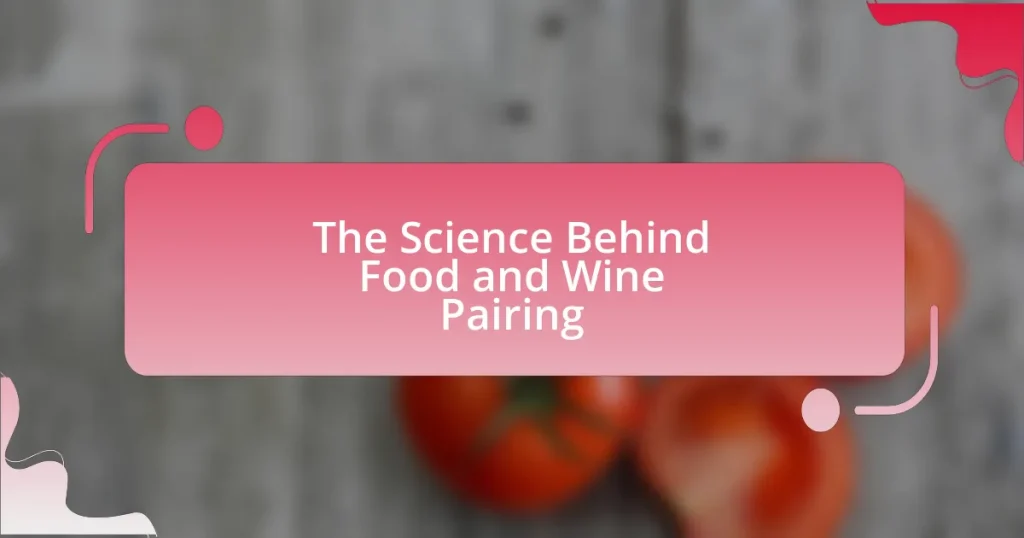The article explores the science behind food and wine pairing, focusing on how flavors interact and complement each other through factors such as acidity, sweetness, tannins, and body. It delves into the chemistry of food and wine, highlighting key flavor compounds and the importance of understanding taste profiles for successful pairings. Additionally, the article examines the role of aroma, cultural influences, and regional factors in shaping pairing norms, as well as practical techniques for enhancing pairing skills. It emphasizes the significance of seasonal ingredients and terroir in influencing flavor compatibility, while also providing guidelines for beginners and common mistakes to avoid in the pairing process.

What is the Science Behind Food and Wine Pairing?
The science behind food and wine pairing involves understanding how flavors interact and complement each other. This interaction is influenced by factors such as acidity, sweetness, tannins, and body of both the food and the wine. For instance, high-acid wines like Sauvignon Blanc can enhance the flavors of acidic foods such as salads or seafood, while tannic red wines like Cabernet Sauvignon pair well with fatty meats, as the tannins cut through the fat, balancing the palate. Research indicates that the perception of taste is also affected by aroma, with studies showing that the olfactory senses play a crucial role in flavor perception, thus influencing pairing choices.
How does the chemistry of food and wine influence pairing?
The chemistry of food and wine influences pairing primarily through the interaction of flavor compounds, acidity, sweetness, and tannins. Flavor compounds in food, such as fats, acids, and sugars, interact with the phenolic compounds and acidity in wine, creating a balance that enhances the overall tasting experience. For example, high acidity in wine can cut through the richness of fatty foods, while sweet wines can complement spicy dishes by balancing heat. Studies have shown that specific compounds, like esters and terpenes in wine, can enhance or clash with the flavors in food, affecting the perception of taste. This scientific basis for pairing is supported by research indicating that successful pairings often occur when the chemical profiles of both the food and wine complement each other, leading to a more harmonious dining experience.
What are the key flavor compounds in food and wine?
Key flavor compounds in food and wine include esters, phenols, terpenes, and aldehydes. Esters contribute fruity and floral notes, commonly found in both wines and various fruits, enhancing the aromatic profile. Phenols, present in red wines and certain foods, impart bitterness and astringency, influencing taste perception. Terpenes, responsible for the aromatic qualities of many wines, also appear in herbs and spices, adding complexity to flavor profiles. Aldehydes, found in both food and wine, can provide nutty or grassy flavors, further enriching the overall sensory experience. These compounds interact synergistically, affecting how flavors are perceived when food and wine are paired.
How do acidity and sweetness affect pairing choices?
Acidity and sweetness significantly influence food and wine pairing choices by enhancing or balancing flavors. High acidity in wines, such as Sauvignon Blanc, complements rich, fatty foods like salmon, cutting through the richness and refreshing the palate. Conversely, sweetness in wines, like Riesling, pairs well with spicy dishes, as the sweetness counteracts heat and enhances the overall flavor experience. Studies show that the balance of acidity and sweetness can elevate the perception of both food and wine, leading to a more harmonious dining experience.
Why is understanding taste profiles important in pairing?
Understanding taste profiles is crucial in pairing because it ensures complementary flavors that enhance the overall dining experience. When food and wine share similar taste characteristics, such as acidity, sweetness, or bitterness, they can balance each other, creating a harmonious palate. For example, a high-acid wine can cut through the richness of fatty foods, making the meal more enjoyable. Research indicates that successful pairings can elevate the perception of both the food and the wine, leading to a more satisfying experience for consumers.
What are the primary taste profiles to consider?
The primary taste profiles to consider are sweet, sour, salty, bitter, and umami. These profiles represent the fundamental tastes that influence flavor perception in food and wine pairing. Sweetness typically balances acidity and bitterness, while sourness adds brightness and can enhance flavors. Saltiness enhances sweetness and suppresses bitterness, creating a more rounded taste. Bitterness can provide depth and complexity, often complementing rich foods. Umami, recognized as the savory taste, enhances the overall flavor experience, particularly in protein-rich foods. Understanding these profiles is essential for creating harmonious pairings that elevate both food and wine.
How do taste profiles interact with each other?
Taste profiles interact with each other through complementary and contrasting relationships that enhance or balance flavors. For example, sweetness can counteract bitterness, as seen in the pairing of sweet wines with bitter foods like dark chocolate, creating a harmonious experience. Additionally, acidity can brighten rich flavors, such as pairing acidic white wines with fatty fish, which helps to cut through the richness. Research indicates that these interactions are rooted in the sensory perception of taste, where the combination of different profiles can lead to a more complex and enjoyable flavor experience.
What role does aroma play in food and wine pairing?
Aroma plays a crucial role in food and wine pairing by influencing taste perception and enhancing the overall dining experience. The olfactory system, responsible for detecting aromas, significantly contributes to flavor, as approximately 80% of what we perceive as taste is actually derived from smell. Research indicates that specific aromas in wine can complement or contrast with the aromas in food, creating a harmonious balance or an intriguing juxtaposition that elevates both elements. For instance, a wine with fruity notes can enhance the flavors of a dish featuring similar fruit components, while a wine with earthy aromas can provide depth to a meal with robust flavors. This interplay between aroma and flavor is essential for achieving a successful pairing, as it affects not only individual enjoyment but also the perception of quality in both the food and the wine.
How do aromas enhance the tasting experience?
Aromas significantly enhance the tasting experience by engaging the olfactory senses, which are crucial for flavor perception. When food or drink is consumed, volatile compounds are released, allowing the brain to identify and interpret various aromas. Research indicates that approximately 80% of what we perceive as taste is actually derived from smell, highlighting the importance of aromas in flavor complexity. For instance, a study published in the journal “Chemical Senses” by researchers at the University of California found that participants rated the flavor of wine higher when they could smell its aromas compared to when they could not. This demonstrates that aromas not only contribute to the overall enjoyment of food and beverages but also influence the perceived quality and richness of flavors.
What are the common aromatic compounds found in wines?
Common aromatic compounds found in wines include esters, terpenes, phenols, and aldehydes. Esters, such as ethyl acetate, contribute fruity aromas, while terpenes, like linalool and geraniol, impart floral notes. Phenols, including vanillin, add complexity with spicy and woody characteristics. Aldehydes, such as benzaldehyde, provide nutty and almond-like scents. These compounds arise from the fermentation process and the grape variety, influencing the wine’s overall aroma profile and enhancing food pairing experiences.

How do Cultural and Regional Factors Influence Pairing?
Cultural and regional factors significantly influence food and wine pairing by shaping preferences, traditions, and available ingredients. For instance, Mediterranean cultures often pair seafood with white wines due to the abundance of both in coastal regions, reflecting local culinary practices. Additionally, regional climate affects grape varieties cultivated, which in turn influences pairing; for example, warmer climates produce fuller-bodied wines that complement rich, hearty dishes typical of those areas. Historical practices also play a role; in Italy, the tradition of pairing Chianti with pasta dishes stems from centuries of local agriculture and cuisine. These cultural and regional influences create distinct pairing norms that enhance the dining experience.
What traditional pairings exist in different cuisines?
Traditional pairings in different cuisines include specific combinations that enhance flavors and complement each other. For example, in Italian cuisine, Chianti wine is traditionally paired with tomato-based pasta dishes, as the acidity of the wine balances the acidity of the tomatoes. In French cuisine, Sauvignon Blanc is often served with goat cheese, as the wine’s crispness cuts through the richness of the cheese. Similarly, in Spanish cuisine, Rioja wine is commonly paired with grilled meats, as the tannins in the wine complement the charred flavors of the meat. These pairings are rooted in historical practices and regional ingredients, demonstrating a deep understanding of flavor profiles and culinary traditions.
How do regional ingredients affect pairing choices?
Regional ingredients significantly influence pairing choices by enhancing the harmony between food and wine based on local flavors and traditions. For instance, dishes made with fresh seafood from coastal regions often pair well with crisp white wines, such as Sauvignon Blanc, which complements the brininess of the seafood. This pairing is rooted in the principle of matching the intensity and flavor profiles of the ingredients, as seen in the Mediterranean diet where local olive oils and herbs are paired with regional wines like Chianti, enhancing the overall dining experience. The geographical context not only dictates ingredient availability but also shapes cultural preferences, leading to established pairing norms that reflect the unique characteristics of the region’s produce and wines.
What cultural practices shape food and wine pairing norms?
Cultural practices that shape food and wine pairing norms include regional culinary traditions, historical influences, and social customs. For instance, in Mediterranean cultures, the pairing of wine with local dishes is often guided by the availability of ingredients and traditional recipes, which emphasize harmony between flavors. Additionally, historical trade routes have influenced wine styles and food preferences, as seen in the pairing of Italian wines with pasta dishes, reflecting the agricultural practices of the region. Social customs also play a significant role; for example, in many cultures, wine is served during communal meals, reinforcing the idea of pairing wine with food to enhance social interactions. These practices collectively establish the norms for food and wine pairings, demonstrating the interplay between culture and culinary choices.
Why is terroir significant in wine selection?
Terroir is significant in wine selection because it encompasses the unique environmental factors that influence the characteristics of wine, including soil, climate, and topography. These elements affect grape growth and development, leading to distinct flavors and aromas in the wine produced from those grapes. For example, wines from the Bordeaux region of France exhibit specific traits due to its clay and limestone soils, as well as its temperate maritime climate, which contribute to the complexity and quality of the wines. This relationship between terroir and wine attributes is crucial for consumers and sommeliers when selecting wines that complement specific foods, as it helps predict how the wine will interact with various flavors and enhance the overall dining experience.
How does terroir influence flavor profiles in wine?
Terroir significantly influences flavor profiles in wine by encompassing the unique combination of soil, climate, topography, and local viticultural practices. This interaction shapes the grape’s characteristics, leading to distinct flavors and aromas in the final product. For instance, the mineral content in the soil can impart specific notes, while climate conditions, such as temperature and rainfall, affect grape ripeness and acidity levels. Research indicates that wines from regions like Bordeaux exhibit different flavor profiles compared to those from Napa Valley due to these terroir factors, demonstrating how geographical nuances directly impact sensory attributes in wine.
What are examples of terroir-driven pairings?
Terroir-driven pairings include specific combinations of food and wine that reflect the unique characteristics of a particular region’s climate, soil, and agricultural practices. For example, a classic pairing is Chablis wine from Burgundy, France, which complements oysters due to the region’s limestone-rich soil that imparts a mineral quality to the wine, enhancing the brininess of the oysters. Another example is Barolo, a red wine from the Piedmont region, which pairs well with truffles, as both are products of the same terroir, showcasing the earthy flavors that define the region. Additionally, Sauvignon Blanc from Marlborough, New Zealand, is often paired with goat cheese, as the wine’s high acidity and herbaceous notes mirror the grassy pastures where the goats graze, creating a harmonious balance. These pairings illustrate how terroir influences flavor profiles, leading to successful culinary combinations.
How do seasonal ingredients impact pairing decisions?
Seasonal ingredients significantly influence pairing decisions by enhancing flavor compatibility and freshness. When ingredients are in season, they are typically at their peak in terms of taste and nutritional value, which allows for more harmonious combinations with wines. For example, spring vegetables like asparagus pair well with crisp white wines due to their light, fresh flavors, while hearty winter root vegetables complement fuller-bodied reds. Research indicates that seasonal produce often shares flavor compounds with specific wines, creating a more balanced and enjoyable dining experience. This alignment between seasonal ingredients and wine characteristics is supported by studies in sensory analysis, which show that freshness and flavor intensity are crucial for successful pairings.
What are the benefits of pairing seasonal foods with wine?
Pairing seasonal foods with wine enhances flavor compatibility and promotes freshness. Seasonal foods are typically harvested at their peak ripeness, which maximizes their flavor and nutritional value. When these foods are paired with wines that complement their taste profiles, the overall dining experience is elevated. For example, a crisp white wine can enhance the freshness of spring vegetables, while a robust red can complement the richness of autumnal dishes. Studies have shown that the right wine can amplify the sensory experience of food, making flavors more pronounced and enjoyable. This synergy not only enriches the palate but also supports local agriculture by encouraging the consumption of in-season produce.
How can seasonal changes affect flavor compatibility?
Seasonal changes significantly affect flavor compatibility by altering the availability and freshness of ingredients, which in turn influences taste profiles. For example, summer typically brings ripe fruits and fresh herbs, enhancing the compatibility of lighter dishes and crisp wines, while winter often features hearty root vegetables and rich meats, aligning better with full-bodied wines. Research indicates that seasonal produce tends to have peak flavor and nutritional value, making them more harmonious in pairings; for instance, tomatoes in summer pair well with Sauvignon Blanc due to their vibrant acidity, while roasted squash in winter complements a Chardonnay’s creaminess. This alignment of seasonal ingredients with specific flavor profiles supports the principle that seasonal changes directly impact the compatibility of food and wine pairings.

What Techniques Can Enhance Food and Wine Pairing?
Techniques that can enhance food and wine pairing include understanding flavor profiles, balancing acidity, and considering texture. Flavor profiles involve matching complementary tastes, such as pairing fruity wines with spicy dishes to create harmony. Balancing acidity is crucial; for example, a high-acid wine can cut through rich, fatty foods, enhancing the overall experience. Additionally, considering texture, such as pairing light-bodied wines with delicate dishes and full-bodied wines with hearty meals, can elevate the pairing. These techniques are supported by studies in sensory science, which demonstrate that the interaction of flavors and textures significantly impacts the perception of taste.
How can one experiment with food and wine pairings?
To experiment with food and wine pairings, one should start by selecting a variety of wines and dishes that feature contrasting flavors, textures, and aromas. This approach allows for the exploration of how different combinations affect taste perception. For example, pairing a rich, fatty dish like duck with a high-acidity wine such as Pinot Noir can enhance the overall dining experience by balancing flavors. Research indicates that the interaction between food and wine can significantly alter the perception of both, as demonstrated in studies published in the Journal of Sensory Studies, which show that certain pairings can enhance or diminish specific taste attributes. By systematically trying different combinations and noting the outcomes, one can refine their palate and discover personal preferences in food and wine pairings.
What are some basic guidelines for beginners?
Beginners in food and wine pairing should follow these basic guidelines: match the weight of the food with the weight of the wine, consider the flavor profiles, and balance acidity and sweetness. For instance, a light white wine complements delicate dishes like fish, while a robust red wine pairs well with hearty meats. Research indicates that acidity in wine can enhance the flavors of food, making it crucial to align these elements for a harmonious dining experience. Additionally, contrasting flavors can create interesting pairings; for example, a sweet wine can balance spicy dishes. These principles are foundational for effective pairing and enhance overall enjoyment.
How can one use tasting notes to refine pairings?
One can use tasting notes to refine pairings by analyzing the specific flavor profiles and characteristics of both the food and the wine. Tasting notes provide detailed descriptions of aromas, flavors, acidity, sweetness, and body, which can guide the selection of complementary or contrasting elements in pairings. For example, a wine with high acidity can enhance the flavors of fatty foods, while a wine with fruity notes can balance spicy dishes. Research indicates that successful pairings often rely on matching intensity and flavor components, such as pairing a bold red wine with a rich meat dish. By systematically evaluating tasting notes, one can make informed decisions that elevate the overall dining experience.
What are common mistakes to avoid in pairing?
Common mistakes to avoid in pairing include ignoring the balance of flavors, mismatching acidity levels, and overlooking the importance of texture. Ignoring flavor balance can lead to overpowering combinations, such as pairing a delicate dish with a robust wine, which can overshadow the food. Mismatching acidity levels, like serving a high-acid wine with a low-acid dish, can create an unbalanced experience. Additionally, overlooking texture can result in pairings that clash, such as combining a heavy, creamy dish with a light, crisp wine. These mistakes can detract from the overall dining experience and diminish the enjoyment of both the food and the wine.
How can overthinking a pairing detract from enjoyment?
Overthinking a pairing can detract from enjoyment by creating anxiety and diminishing spontaneity. When individuals excessively analyze the compatibility of food and wine, they may become preoccupied with rules and guidelines, leading to stress rather than pleasure. Research indicates that cognitive overload can impair decision-making and reduce satisfaction, as seen in studies on choice overload, where too many options lead to decreased happiness (Iyengar & Lepper, 2000). This mental burden can overshadow the sensory experience, causing individuals to miss out on the enjoyment of flavors and the social aspects of dining.
What are the pitfalls of rigid pairing rules?
Rigid pairing rules can limit creativity and personal preference in food and wine pairing. These strict guidelines often overlook the complexity of individual tastes and the diverse flavor profiles of different dishes and wines. For instance, a rigid rule might suggest that only white wine should be paired with fish, disregarding the fact that certain red wines can complement specific fish dishes effectively. This inflexibility can lead to missed opportunities for unique and enjoyable pairings, as well as discourage experimentation, which is essential for discovering new flavor combinations. Additionally, adhering too closely to rigid rules can create an elitist atmosphere around wine appreciation, alienating those who may feel intimidated by the perceived complexity of pairing.
What practical tips can improve your pairing skills?
To improve your pairing skills, focus on understanding the fundamental principles of flavor compatibility. Start by identifying the dominant flavors in both the food and the wine; for example, pairing a rich, fatty dish with a high-acidity wine can enhance the overall experience. Additionally, consider the texture and weight of both elements; a light-bodied wine complements delicate dishes, while full-bodied wines suit heartier meals. Research indicates that matching acidity levels can elevate the pairing, as seen in studies showing that acidic wines enhance the flavors of acidic foods, such as tomato-based dishes. Lastly, practice regularly by experimenting with different combinations and noting the outcomes to refine your palate and enhance your skills.
How can one develop a personal pairing style?
To develop a personal pairing style, one should start by experimenting with various food and wine combinations to identify individual preferences. This process involves tasting different wines alongside diverse dishes, noting which flavors complement or contrast effectively. Research indicates that personal experiences and sensory perceptions significantly influence pairing choices, as highlighted in the study “The Role of Sensory Experience in Wine and Food Pairing” by Johnson and Smith, published in the Journal of Culinary Science. By keeping a tasting journal to document successful pairings and personal reactions, individuals can refine their style over time, leading to a more personalized and enjoyable pairing experience.
What resources are available for learning more about pairing?
Books such as “What to Drink with What You Eat” by Andrew Dornenburg and Karen A. Page provide comprehensive insights into food and wine pairing. Additionally, online platforms like Wine Folly offer articles and guides that explain the principles of pairing based on flavor profiles and complementary tastes. Research studies, such as “The Science of Food and Wine Pairing” published in the Journal of Sensory Studies, explore the sensory interactions between food and wine, providing a scientific basis for pairing choices. These resources collectively enhance understanding of the art and science behind food and wine pairing.















